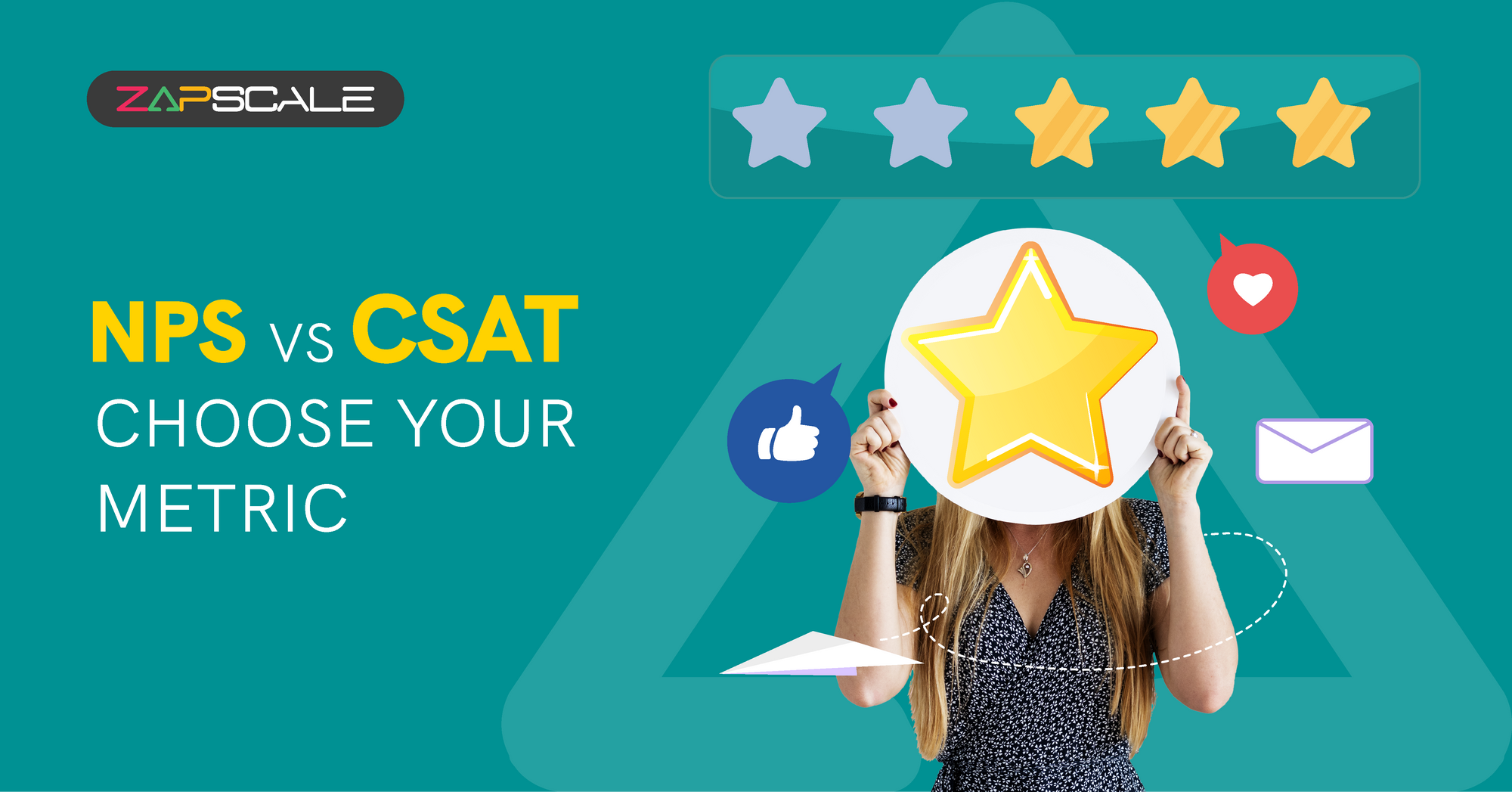CATEGORY > CS Metrics
What is a Net Promoter Score (NPS) and why is it important?

Have you ever filled out a survey that asked you to rate the likelihood that you’d recommend a product or brand to someone? Ever wondered what is that small and simple survey for? Well, that survey is a benchmark for businesses to measure customer satisfaction and ascertain loyalty, commonly known as Net Promoter Score (NPS). It is an index between -100 and 100 that measures the likelihood of customers recommending a business’ products/services to others. Positive NPS shows the color green and negative shows red. Why do they always consider Yellow a mediocre color? Anyway!

The general notion is that the customers in green are extremely crucial as they are the most satisfied customers of our business. But is that so?
I would say the customers in Red are extremely crucial as they are the ones losing interest in your business and might impact the customers in green in the future.
Transactional vs Relational NPS Programs
Focus
Transactional NPS targets specific interactions, and relational NPS assesses the overall relationship
Timing
Transactional NPS is immediate, and relational NPS is periodic.
Actionability
Transactional NPS allows for quick fixes whereas relational NPS guides long-term strategies
Insights
Transactional NPS provides specific, event-related insights while Relational NPS offers a comprehensive view of customer loyalty and satisfaction over time.
Use Cases
Transactional NPS is useful for pinpointing strengths and weaknesses in particular places or touchpoints while relational NPS is best for understanding and enhancing overall customer loyalty and long-term satisfaction.
How To Calculate The Net Promoter Score?
The customer is asked to rate on a 0-10 scale, the likelihood of her recommending the product/ service or the company/brand to someone. Then their ratings are consolidated to classify these customers as Promoters (rating 9 or 10), Passives (rating 7 or 8), or Detractors (rating 0-6).

As the name suggests, the promoters love the product or services, are going to buy again, and will bring in more potential customers to the company.
The detractors, on the contrary, are the customers who are not likely to purchase again and can possibly harm the company’s name through bad word of mouth.
Passives lie in between, they are not very enthusiastic about the products or services and can easily switch between competitors. They will obviously not promote the products, but won’t bad mouth them either.
The net promoter score is calculated by deducting the percentage of detractors from the percentage of promoters.
NPS = (# promoters/ # total respondents) – (# detractors/ # total respondents)
Why Do We Need NPS?
There is a positive correlation between the company’s NPS and its growth. But, NPS has to be made a part of the organization’s ecosystem to bring in any substantial value. Nonetheless, NPS does provide many benefits to a business.
Word-of-mouth quantification
It has been established that more than 92% of customers trust the word of their family and friends more than any other form of advertising. When we know that this form of advertising is so strong, especially in developing markets, quantifying it really helps in efforts towards increasing word-of-mouth marketing.
Benchmarking customer quality
Tracking NPS helps us in quantifying the customer quality we cherish. Apart from the quantitative questions to rate their feedback, NPS surveys also have qualitative questions, asking the customer to explain why they chose the rating.
Companies use this response to polish their stakeholder interactions, product improvement, and development, and to demonstrate their commitment to customer success to potential and existing customers.
What Can You Measure Using NPS?
Net promoter Score is a metric that helps businesses measure various aspects of customer and employee satisfaction. It is very important to understand what NPS can measure to leverage its full potential.
1. Customer Loyalty And Satisfaction
The primary use of NPS is to gauge customer loyalty and satisfaction. By asking the question “ How likely are you to recommend our product/service to a friend or colleague?”, businesses can calculate their NPS to understand the overall sentiment of their customers.
2. Product And Service Feedback
NPS surveys can be tailored to gather feedback on specific products or services. By calculating the net promoter score for different offerings, businesses can identify areas for improvement, guiding product development and customer service strategies.
3. Customer Experience
NPS can measure the overall customer experience across various touchpoints. Whether it’s during a purchase, after a service call, or following an online interaction, NPS helps evaluate customer satisfaction at different stages of the customer's journey.
How Do You Create An NPS Survey?
Crafting an effective Net Promoter Score is essential for gathering valuable insights into customer loyalty and satisfaction.
Let’s look at a quick guide to create one:
- Define objectives determine the survey’s purpose and set clear goals
- Select and target audience for your survey
- Use the standard NPS question: “On a scale of 0 to 10, how likely are you to recommend our product/service?’’
- Include follow-up questions, to gather qualitative and quantitative feedback
- Choose a user-friendly platform, keep the layout simple, and customize it with your brand color
- Decide how to distribute the survey (SMS, Email etc), and consider timing and frequency
- Calculate the NPS, analyze qualitative feedback, and identify trends
- Continuously review and refine the survey process based on feedback
Are There Any Limitations Of NPS?
While NPS helps businesses in quantifying their customer responses, it fails to provide any substantial insight into customer loyalty or predict the current company performance as a whole.
Moreover, pivoting the decision-making process on a single predictor is much more volatile than relying on multiple indicator models like CFMs (customer feedback metrics). Lastly, without any laid-out plans to act on the NPS, it will serve no use to the company, except for being just another piece of static information.
How To Use NPS?
NPS can be used as a company-wide KPI to measure the customer focus and benchmark it against its competitors, by measuring NPS at the organizational level as a top-down approach.
A bottom-up approach can also be used, where NPS is measured at customer touchpoints to influence customer management and design diagnostic tools to analyze customer loyalty.
Various NPS software tools like Survey Monkey, Satmetrix, etc. can be used to collect and analyze data. Customer feedback software tools also come in handy to gather data for NPS quantification.
Market leaders like P&G, Amazon, eBay, Microsoft, SAP, KPMG, Best Buy, etc. are already using NPS to their advantage. When are you?
FAQs
1. Why is NPS important?
NPS provides organizations with valuable insights into customer satisfaction and loyalty. It helps you to identify areas of improvement, measure the effectiveness of customer experience initiatives, and track changes in customer sentiment over time.
2. How frequently should the NPS survey be conducted?
The frequency of NPS surveys depends on the organization’s goals, industry dynamics, and customer lifecycle. Some organizations conduct NPS surveys quarterly, while some may opt for more frequent or less frequent intervals based on their specific needs.
3. Can NPS be influenced by external factors?
Yes, NPS can be influenced by external factors such as market trends, competitor actions, economic conditions, and regulatory changes. Organizations need to consider these factors when interpreting NPS results and making business decisions.
ABOUT THE AUTHOR
Popular from CS Metrics
Quality Content,
Straight To Your Inbox!
Subscribe for the latest blogs, podcasts, webinars, and events!

Write a Blog
If you have experience in CS and
a flair for writing, we’d love to
feature you.
Write to us on
hello@zapscale.com






